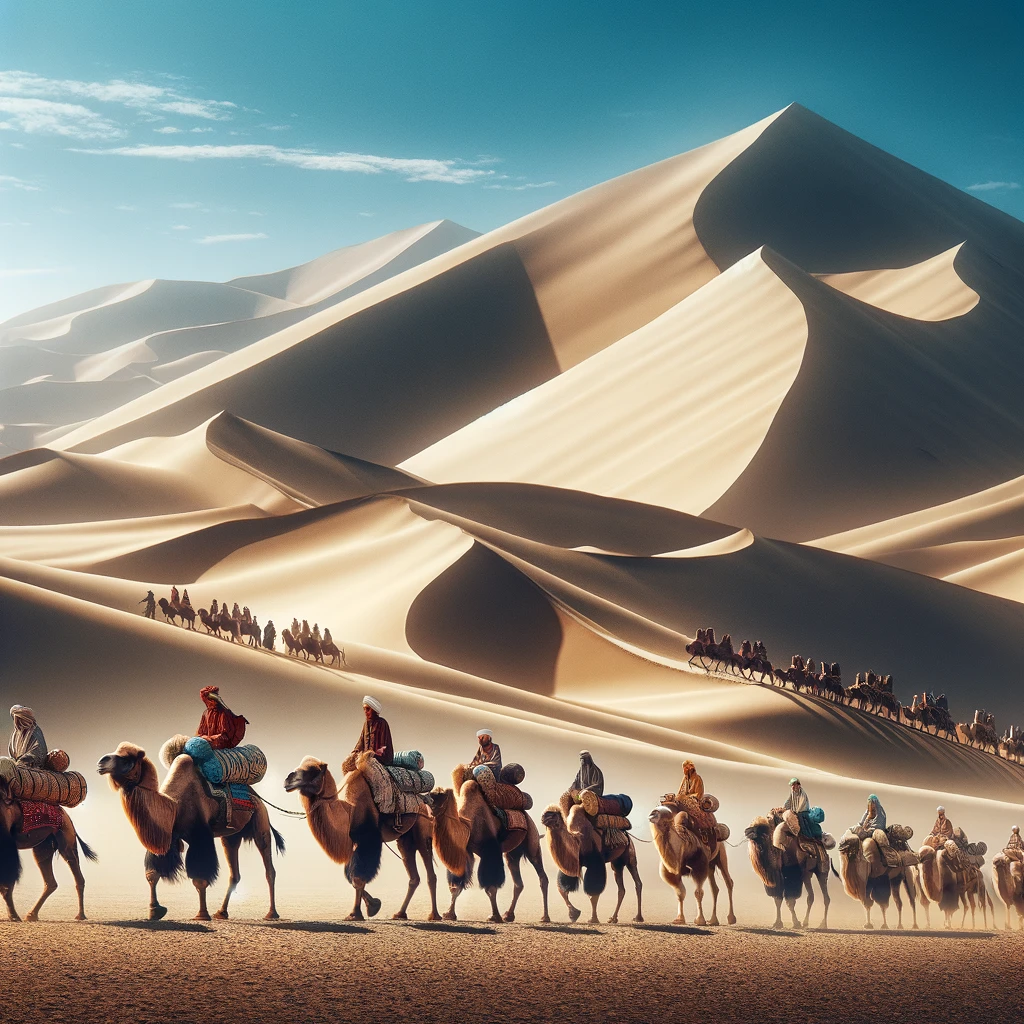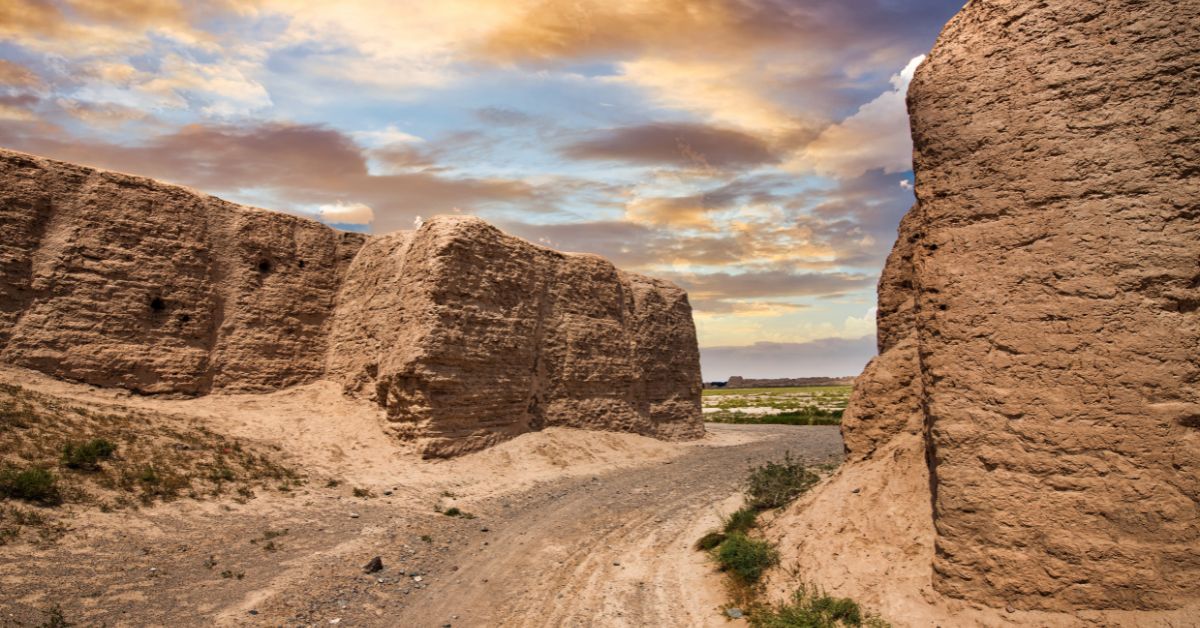The Silk Road Gobi Desert, spanning across western China and Mongolia, holds a timeless allure, once a thriving artery for trade routes connecting China, Central Asia, and the West.
This vast expanse of sand dunes and rugged landscapes played a pivotal role in the Silk Road trade, facilitating the exchange of precious stones, textiles, and ceramics between merchants and Buddhist monks.
Today, the rest of the Gobi Desert remains a destination of historical and cultural significance, attracting modern-day tourists eager to explore its ancient past.

Key Takeaways
- The Gobi Desert was a crucial hub in the Silk Road routes, where caravans of merchants traveled with goods like silk, lapis lazuli, and tea.
- Buddhist monks and scholars used these trade routes to spread religious teachings, leading to the creation of sites like the Mogao Caves and the Caves of a Thousand Buddhas.
- The legacy of the Silk Road is still evident in towns, preserved relics, and cultural exchanges between East and West.
Central Asia’s Gateway on the Silk Road Gobi Desert
Spanning across China and Mongolia, the Gobi Desert was a natural corridor for traders and Buddhist monks traveling along the Silk Road trade network.
This route was essential in the first millennium, particularly around the first century AD, shaping the economies and cultures of civilizations from the Taklamakan Desert north to the Altai Mountains.
The region became a meeting point for diverse cultures, influencing textiles, ceramics, and glassware that were traded between India, China, and the West.
The flow of goods was not limited to material wealth but also included knowledge, such as the spread of the Diamond Sutra, the world’s earliest known printed book, discovered in Dunhuang.

Landmarks Along the Silk Road Routes in the Gobi
The Mogao Caves and the Buddhist Heritage
Located near the city of Dunhuang, the Mogao Caves, also known as the Caves of a Thousand Buddhas, stand as a testament to the nature of the religious and cultural exchanges along the Silk Road.
Dunhuang caves, often referred to as a blazing beacon, played a crucial role in the communication and safety of the Silk Road routes. These caves were created by Buddhist monks over centuries, filled with murals and statues depicting life from various Silk Road routes.
These artworks reveal the influence of Chinese, Indian, and Central Asian cultures, showing how trade routes were also conduits for religious and artistic inspiration. The discovery of ancient manuscripts, including the Diamond Sutra, further highlights the Silk Road Gobi Desert as an intellectual hub.

The Great Wall’s Role in Protecting Trade Routes
Stretching into sections of the Gobi Desert, the Great Wall was constructed in various centuries AD to protect trade caravans from raids.
This fortification allowed the exchange of goods like silk, textiles, and ceramics to flourish, ensuring the safety of traders navigating the Silk Road routes.
The Altai Mountains and Livestock Trade
To the north of the Gobi Desert, the Altai Mountains were crucial for merchants and traders crossing between Central Asia and China. The region was not only a resting point but also an area where livestock was raised and traded, providing caravans with necessary resources.

The Silk Road Today: Legacy and Continuity
Though the camel caravans have been replaced by modern transportation, the significance of the journey through the Silk Road Gobi Desert endures.
The footprints of the earliest Buddhist monks, merchants, and explorers remain etched in the ancient sites and preserved relics found throughout the region.
Today, the Silk Road trade has evolved into cultural tourism, with visitors traveling to see landmarks like the Mogao Caves, blazing beacons, and oases that once supported caravans along the Silk Roads.
The remnants of historic towns continue to rise up to narrate the stories of past traders, revealing the importance of this vast desert in shaping global history.

The Economic Impact of the Silk Road Gobi Desert
The modern impact of the Silk Road is evident in the continued exchange of goods and ideas between China and Western countries. Regions like Dunhuang, a city once thriving on Silk Road trade, now attract tourists who seek to understand the historical connections between Asia, Europe, and the Middle East.
Additionally, Silk Road cities that once depended on traders have now transformed into modern cultural hubs, where markets, museums, and preserved relics continue to tell the stories of ancient trade and knowledge exchange.

The Silk Road Gobi Desert remains a symbol of cultural and economic exchange. From the Mogao Caves to the Altai Mountains, the journey of the region’s traders, Buddhist monks, and merchants shaped the history of Central Asia.
As tourists explore these ancient sites, the legacy of the Silk Road routes continues to influence our understanding of globalization and world connectivity through the ages.
If you would like to read more, check the following links
- Gobi desert animals
- Gobi Desert Plants
- Gobi Desert Mongolia
- Mongolia Snow Leopard Facts – Habitat, Population, and Conservation Efforts
- Snow Leopard Gobi Desert: A Magnificent Beast in a Hostile Landscape
- The Gobi Desert Facts: Top 5 Only Nomads Know in Mongolia
- Gobi Desert Food Web: Plants, Animals, and Ecosystem Explained










